My weblog ELECTRON BLUE, which concentrated on science and mathematics, ran from 2004-2008. It is no longer being updated. My current blog, which is more art-related, is here.
Sat, 26 Apr, 2008
Recovered Memories in Blue
I've been transcribing old color slides to digital images using my studio scanner. These are slides I took in 1964 when I was at summer camp in New Hampshire. I went to a girls' camp named Camp Idlepines, located in a remote and unspoiled part of New Hampshire. I was a camper there for three summers: 1963, 1964, and 1965. In my recollection, I was a whiny, complaining, spoiled "behavior problem" who vexed counselors and other campers alike. But I must have enjoyed some parts of my camping experience, and must have liked at least a few of the other girls there, because I took pictures of them. I don't remember most of their names, but I will find out soon. The people who ran the camp are still alive and are trying to contact as many of their former campers as they can, including me. The two sisters who led the camp asked specifically about me, perhaps curious to learn how the "behavior problem" turned out.
I unpacked the slides from their hiding place, where I had kept them for decades. The slides are 35 millimeter half-frame exposures. They were taken on a camera called the Olympus Pen, which my folks had given me a year or so earlier. This little camera lasted me until the late seventies, when it finally wore out. So I have boxes and boxes of tiny slides, including my Camp Idlepines pictures.
My scanner didn't like the half-frame film size. It is set to recognize full-frame 35mm slides or negatives, as they are set in a plastic grid on the scanning plate. So in order to get good scans of the 35mm films, I had to do them one by one, patiently adjusting the machine's scan "window" to cover each one. The slides were also very dusty, and even blowing air and a clean paintbrush didn't get all the dust off. Fortunately, dust specks and discoloration can now be removed through the technological marvel of Photoshop.
When I started scanning these pictures, I realized that the film had faded. This was to be expected, even if it were not exposed to light. The reds and the yellows in the color balance had faded, leaving an intense bluish cast to all the pictures. So not only did I have to work on editing out the dust specks, I had to restore the "natural" color to all these old films, using the built-in adjustments provided by Photoshop. I adjusted color balance, brightness and contrast, lightness and sharpness. I added color to some faded photos, using "transparent" overlays of digital tint. Some of the photos needed very special treatment to bring out any image at all. At the age of 11, I just wasn't that good a photographer, and some of the pictures were very underexposed. I could see, though, that these nearly black slides had a recognizable image buried in the darkness.
I devised a crude but effective way to retrieve the color images from my very underexposed dark slides. I mounted the slide in a black paper "mask" and held it up to a very bright light. Then when I had the image in view, I took my digital camera, set to "close range," and photographed the slide with the bright light (my studio table light) shining through it. Then I worked on the digital photo, bringing out as much detail and color as possible. They weren't ever going to be great photographs, but at least a face and a figure is clearly visible in these images, finally, after more than forty years.
The blue-ness remains, however. Some of this is true-to-life. I remember being enthralled by the intense, brilliant blue of the sky over this part of New Hampshire, far from polluting cities. Some of the images are just pictures of sky and leaves, and I remember taking them just to document how bright the greens and blue were. I loved the forest, and I remember spending as much time alone among the trees as possible. I took many pictures of dappled sunlight among dark green leaves, though some of these photographs are not easily recovered. The reflecting surface of the lake, where the camp had its waterfront, was often a brilliant blue as well. I hated swimming, but I loved boating, and I found pictures of the beautiful aluminum canoes I had learned to paddle.
Another series of photos I retrieved were of a day spent climbing Mount Chocorua, a 3500-foot peak in the White Mountains, noted for its rocky bald summit. Here we are climbing up the trail toward the top.
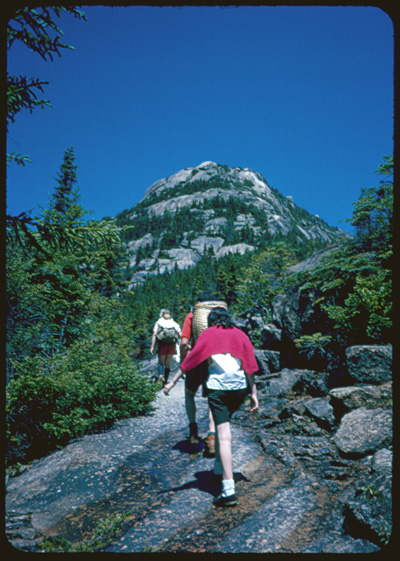
I clearly remember this hike, which I enjoyed, and I brought my Olympus Pen with me. It was a perfect day, and the blueness of the view from the top of the mountain has not faded at all.
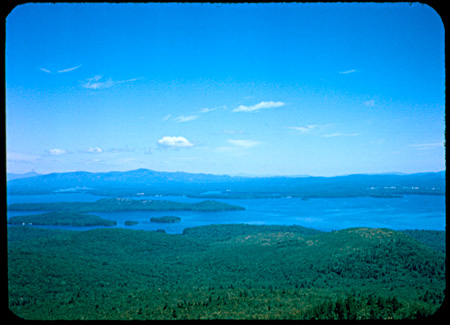
Since I just spent a peaceful, outdoor weekend in another beautiful location, my mind is still out there with the trees and the birds. Maybe someday I'll see skies this blue again.
Posted at 1:36 am | link
Tue, 22 Apr, 2008
The Farmhouse at Temenos
I spent a peaceful, nature-filled weekend with a few of my friends at Temenos Retreat House near West Chester, Pennsylvania. I did lots of hiking and birdwatching. The food was hearty and delicious, and there was good fellowship as well. This was a very welcome rest from the teeming stressful ant-heap of Edge City Tysons Corner.
I also had time to sit and draw some of the old nineteenth-century buildings on the retreat center grounds. The "Old Farm House" is a historic building that is locally famous and I spent a very pleasant time on the site doing its portrait. This is not the place where I spent the retreat, that is a much more modern building elsewhere. My drawing is in ink and greyscale markers, about 7" x 10".
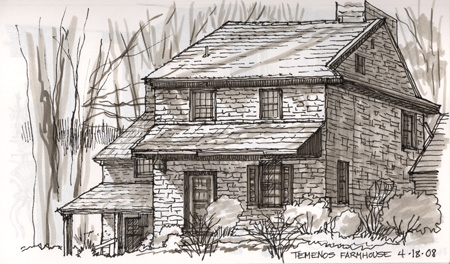
Posted at 12:26 am | link
Mon, 14 Apr, 2008
Trigonometric Earth
Imagine that the Earth was a geometric object, a sphere only slightly out of true. Well it is a geometric object, since after all, geo = earth. Trigonometry originated not in abstract numbers but in real measurements of real landscapes and landmarks. Everywhere I look on this planet, I am looking at trigonometry, with the right angles being those made by the downward pull of gravity, perpendicular to the surface of the Earth sphere. This is not Newtonian or even Galilean, it is much earlier, originating in antiquity with Babylonian triangles and Hellenistic plumb bobs.
If I wanted to use calculus I could claim that even though I am placed on a sphere with a curved surface, that point of perpendicularity (or a tangent, horizontally) is a moment of flatness. Gravity points down to a derivative that is a tiny piece of flat earth. Disregard those hills and valleys, the Earth is flat, at least where gravity puts its point.
Trigonometry places its measurements in a "unit circle," a universal circle whose radius is always ONE. If Earth is a unit circle, a perfect section of a sphere, does that mean that Earth is a unity? Utopians wish for Just One Earth where everyone lives in "harmony," a Pythagorean dream. But the measurement of radians insists that all circle circumferences and the angles that sector them are all some measure of Pi. Everywhere a circle goes, there goes Pi. Is it possible to have a circle whose circumference is a rational number? Perhaps it isn't. Earth will always be irrational, and its numbers will never end.
"Earth Unit Circle," acrylic on black-coated thick paper. 10" x 10"
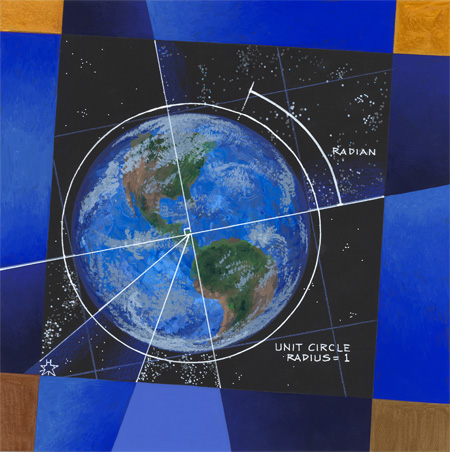
Posted at 1:53 am | link
Wed, 09 Apr, 2008
Parabolic Weave
Here's the next picture in the geometric abstraction series I am doing for the upcoming convention show in May. This one was inspired by the colorful weaving that a friend of mine is doing. I am also experimenting with different textures in this piece by using colored pencils for some of the areas. There is only one curved line in the picture, which is part of a rather wide parabola.
"Parabolic Weave," 10" x 8". Colored pencil and acrylic paint on thick orange paper.
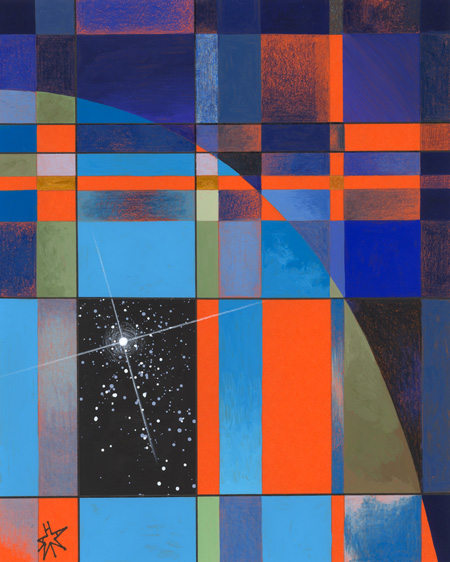
Posted at 3:00 am | link
Sun, 06 Apr, 2008
Au Clair de la Lune
Just a couple of weeks ago, scientists at U.C. Berkeley and audio historians announced the recovery of the oldest surviving recording of the human voice. This is one of the oldest recordings ever, from the very beginning of sound technology. The French inventor Edouard Leon Scott had used a "phonautograph" to etch patterns of sound onto a piece of paper "coated with black soot from an oil lamp." He was not intending to record sounds for playback, but to find visual patterns in the sounds he made into "phonautograms." These were preserved in the French patent office and now, almost 150 years later, they were digitally scanned and sent to California to be decoded.
The Berkeley scientists were able to retrieve ten seconds of a recording from 1860, where a woman sings a line of an old French folk song, "Au Clair de la Lune." I remember this song from my own youth, when along with a little group of neighborhood kids, we learned basic French from a private teacher who held classes in her own home. It surfaces in French and other European music, quoted humorously in Saint-Saens' "Carnival of the Animals," and referenced in a stranger way (though without the tune) by Belgian poet Albert Giraud, and then by Arnold Schoenberg in his setting (in 1912) of Giraud's "Pierrot Lunaire."
The recovered recording from 1860 is hardly high fidelity. In fact, without a lot of processing by audio experts, it would barely be audible at all. It only lasts ten seconds or so, with the voice hardly distinguishable from the noise. The female voice, warbling due to the unsteady speed of the turning phonautograph, sings her "Au Clair de la Lune" line without time or inflection, as if the inventor had asked his sound model to sing the notes slowly and deliberately so that they would register on his rotating medium. The instrument itself, as depicted in the picture in the article, has wonderful nineteenth century design elements in its stand, created in an era when scientific and technological equipment still had space for ornamentation. It reminds me very much of the current pop postmodernist aesthetic known as "steampunk," in which Victorian design, fashions, and old technologies are adapted into a modern technological alternate world. In a steampunk conception, we would be reading this on an "electric intelligence lantern" and typing our messages on a keyboard that looked like this.
The ghost-like, heavily distorted voice coming to us from distant 1860 also recalls another current design trend, sometimes called "deconstructed," "distressed," or "grunge," where an otherwise clear source is deliberately degraded and made to look very old or damaged by disaster or vandalism. In graphics, there are endless amounts of auxiliary programming for Photoshop to create effects like this. Deconstruction works for sound as well, and the ambient and experimental composers whose works I listen to, often work over sounds this way. Perhaps some ambient composer will ask someone to sing a simple song line into his phonautograph, and process it through his electrical intelligence engine so that it can reverse time back to an 1860 that never was.
Posted at 3:57 am | link
